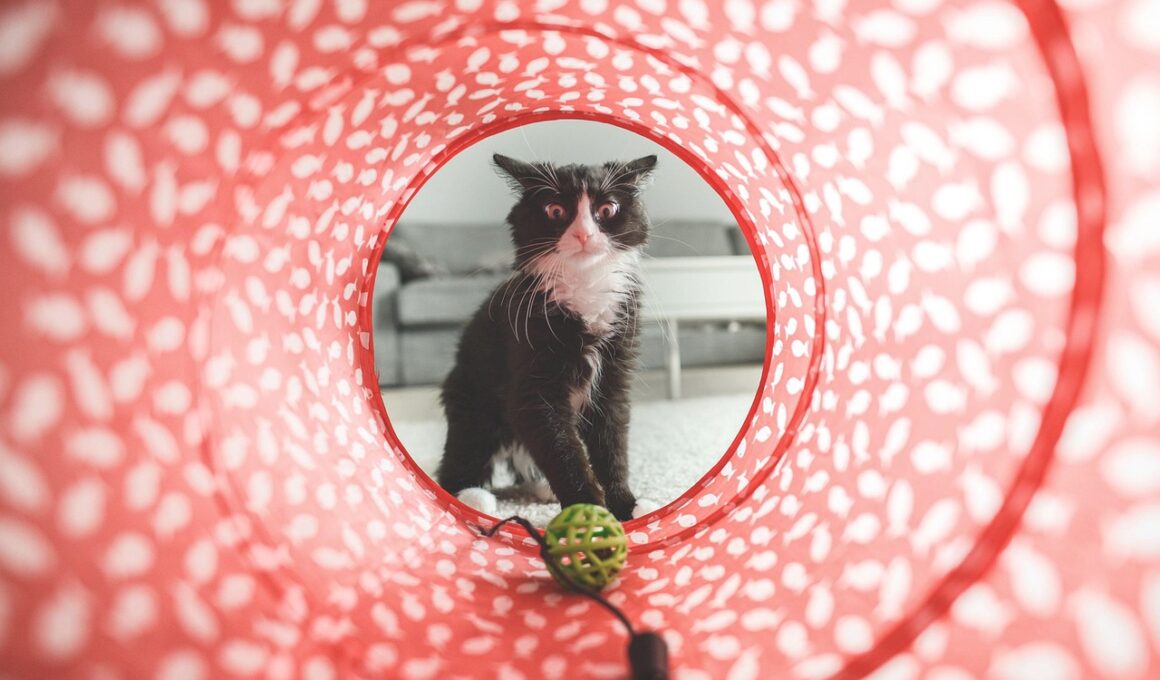Safe Toys and Scratching Alternatives to Deter Nail Biting
Understanding why your cat might be biting its nails or over-grooming is crucial. Often, nail biting stems from stress or boredom. Cats need to have proper outlets for their energy. Providing stimulating toys and scratching alternatives can help alleviate these behaviors. One effective approach is to invest in various engaging toys that can capture your cat’s attention. These toys may include interactive gadgets that mimic prey movements, tantalizing feather wands, or puzzle toys that dispense treats. By introducing these toys, your cat will feel less inclined to focus on its nails. Regular playtime can significantly reduce anxiety, resulting in less nail biting and over-grooming. Additionally, scratching posts are essential. They give your cat a space to scratch without damaging your furniture. Consider placing scratching posts in strategic spots around your home. If possible, opt for cat trees that combine scratching areas and play spaces. Overall, monitoring your cat’s behavior along with providing toys and scratching options is key to reducing discomfort. Once your cat is actively engaged, you should notice fewer incidents of nail biting, and their coats will appear healthier and more vibrant. Keep a close eye on their habits, as early intervention is crucial.
Furthermore, creating a comfortable environment can be an essential strategy in addressing nail biting and over-grooming. Ensure your cat has a dedicated private space for resting and lounging. This can lead to increased feelings of security and relaxation. Incorporating cozy bedding with added textured materials can promote comfort. Consider using soft blankets or padded mats that your cat enjoys. Additionally, calming scents can help reduce anxiety; consider feline pheromone diffusers that promote a sense of calm. These diffusers mimic the natural pheromones that occur in cat’s natural habitat. Placing scratching posts near these calming scents can further entice your cat to utilize them instead of biting its nails. The position of the scratching post plays a significant role as well; cats often prefer vertical surfaces for scratching. Providing an array of options in terms of textures and angles can help meet your cat’s preferences. It is also wise to regularly assess how your cat interacts with various items in your home. Observing which toys excite them most can offer insights for purchasing effective alternatives. Engaging with your cat during these playful moments strengthens your bond while encouraging better habits.
Types of Safe Toys for Cats
Choosing the right toys for your cat is vital for encouraging healthy grooming habits. Look for durable materials that are safe and nontoxic. Fishing pole-style toys are excellent, as they encourage exercise and mimic the hunt. These toys often get your cat’s heart racing, diverting their attention from their nails. Opt for toys that can contain catnip, as many cats find them irresistibly enticing. Other toys, like laser pointers, promote active play while enhancing your bond. Interactive toys that respond to your cat’s movements can keep them engaged for hours, which is crucial for managing stress levels. Additionally, puzzle toys that challenge your cat mentally provide great stimulation. These toys can help deflect attention from nail biting and provide a rewarding experience as they work for treats. You should also rotate the types of toys available to your cat periodically to maintain their interest. By continually introducing new challenges to your cat’s playtime, you foster an environment that encourages active engagement. Ensure to supervise your pet play, checking for any wear that could pose choking hazards or injury. This vigilance safeguards your feline’s play against any unforeseen circumstances.
The choice of scratching alternatives can heavily impact nail biting tendencies. Besides traditional scratching posts, consider cardboard scratchers or mats, which many cats love. These are often more affordable and easily replaceable when worn out. Some cats enjoy angled scratching surfaces, while others favor vertical ones. Observe your cat’s preferences and adapt their environment accordingly. You can also enhance the appeal of scratching posts by sprinkling catnip on them or using sprays designed to attract cats. Moreover, placing scratching posts in popular areas makes them more accessible, ultimately promoting their use. Consider dual-purpose alternatives, such as scratching furniture that doubles as a resting area. As your cat scratches instead of biting nails, observe the improved condition of their claws and coat. Furthermore, frequent nail trimming can help discourage excessive biting. Create a routine that gradually acclimates your cat to nail trimming. Utilize treats and a calm environment to make the process a positive experience. Properly trimmed nails are less pronounced, which can reduce the urge to bite. If the behavior continues despite efforts, consulting a veterinarian may unveil other underlying issues that require addressing.
The Role of Playtime in Cat Behavioral Health
Playtime is essential for maintaining your cat’s psychological and physical health while preventing undesired habits. Regular interactive sessions allow your cat to exert their natural predatory instincts. Engaging with your cat through toys provides vital exercise, burns off excess energy, and ultimately reduces stress. The relationship between play opportunities and over-grooming or nail biting is significant and should not be underestimated. Ensure to dedicate time each day to initiate these playful encounters. Furthermore, diversifying playtime routines can help keep things fresh and exciting, reducing boredom. Introduce toys that move unpredictably or simulating prey to your cat’s preferences. Observe your cat’s reactions; their excitement can guide what types of toys or games resonate most. This engagement creates a bond between you and your pet, building trust and comfort. Additionally, you can involve treat rewards during playtime, which reinforces positive behavior. Utilize reward-based systems that encourage your cat to interact with its toys. Accessing this playful momentum helps alleviate anxiety. Cats often feel more secure when they express their energy in healthy ways, leading to better overall behavior. This connection between play and welfare is vital for a happy, healthy feline.
Incorporating a variety of textures in your home can further deter nail biting and support healthy habits. Cats are naturally drawn to different surfaces, making texture choice pivotal in their environment. Look for options such as sisal, carpet, and natural wood when choosing scratching posts and pads. Cats also find satisfaction in various materials, providing sensory stimulation without resorting to harmful habits like nail biting. Furthermore, ensure the scratching surfaces can be durability tested. Cats naturally have strong scratching instincts, requiring robust materials that withstand their claws. You can even create a designated play space that combines various scratching materials, maintaining your cat’s interest. Mix it up! Try incorporating plush or crinkly materials into toys to capture your cat’s attention. The sensory experiences can alleviate stress, encouraging your cat to abandon nail biting habits. Be mindful of regularly cleaning and inspecting these surfaces to ensure safety and hygiene. Clean toys and scratching posts also promote interest by revealing new scents, whether from previous use or play. Consistent evaluation of your cat’s interaction with these materials allows for modification and adaptation over time, ensuring a continuously stimulating environment.
Conclusion: Path to Healthier Habits
By prioritizing safe toys and scratching alternatives, you vastly improve your cat’s behavioral health, reducing nail biting and over-grooming. Recognizing the underlying stressors leads you to provide effective solutions that cater to their needs. Playtime serves as an essential vehicle for fostering well-being, while the right materials enhance their environment. Monitoring your cat’s preferences plays a critical role in addressing behavioral issues effectively. Your engagement encourages your cat to explore healthier outlets and reduces anxiety, which can manifest in harmful habits. Consistently providing stimulation maintains curiosity and promotes interaction, essential for mental health. Remember, every cat is unique, so experiment with various options until you discover what captivates your pet the most. The ultimate goal is to create a harmonious living space where your cat can thrive without resorting to destructive or stressful behaviors. Regular play, strategic placement of scratching posts, and maintaining an engaging environment are fundamental to achieving these outcomes. As your cat begins to show positive changes, take pride in your commitment to their well-being and comfort. The end result will be a happier, healthier feline that engages joyfully, leaving nail biting a distant memory.


